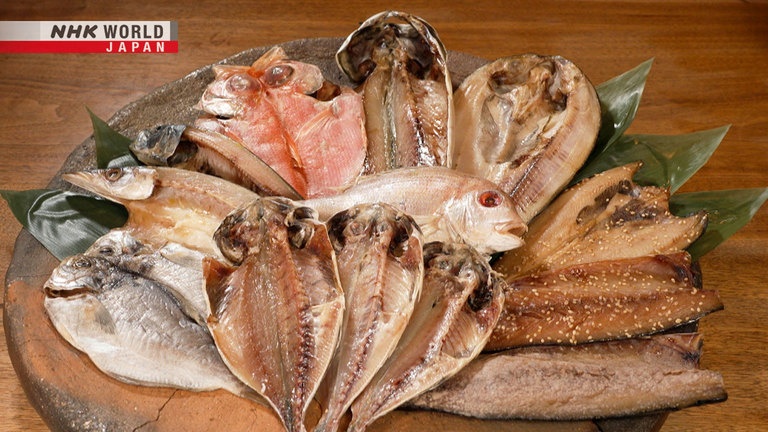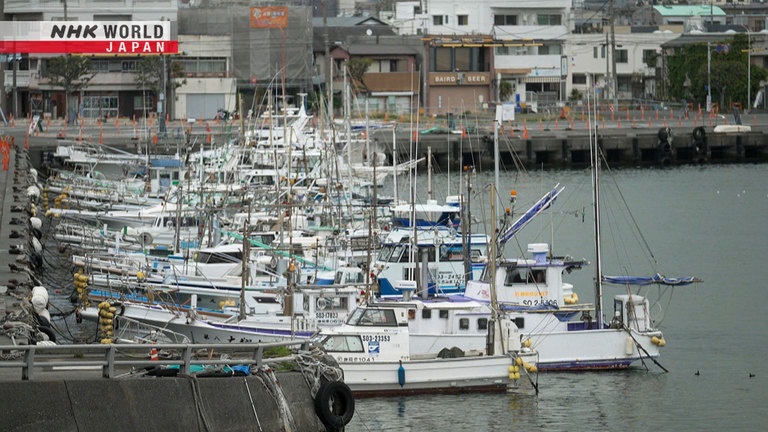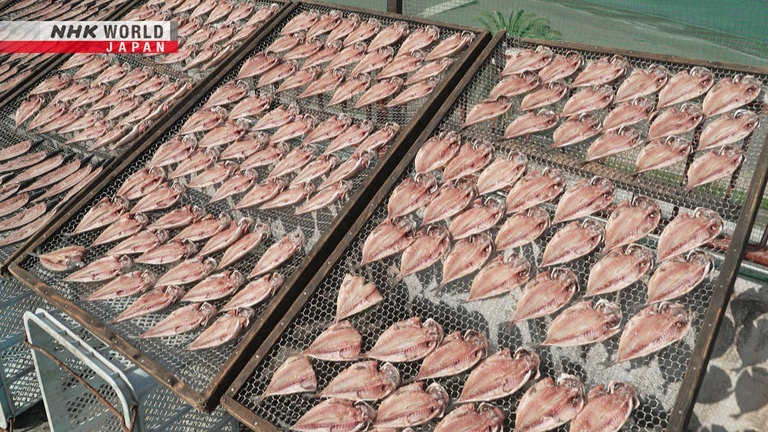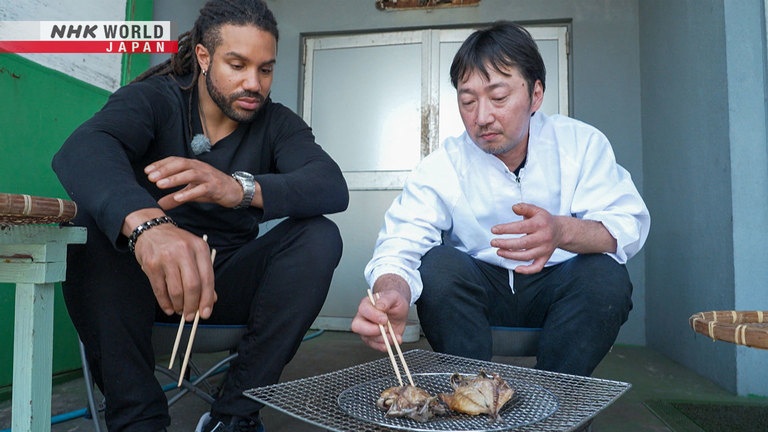HIMONO
Himono, or dried fish, is a product of Japan's long history as an island nation blessed with seafood. Armed with wisdom from the past, preservation methods have evolved to enhance flavor. How does it get so juicy and packed with umami? Visit a key production area to see artisans at work, and feast your eyes on himono dishes that are reinventing the wheel. (Reporter: Alexander W. Hunter)




Transcript
Tokyo: this world-class metropolis is a veritable gourmet wonderland.
Discover the stories behind the ingredients that make this city so delicious - so "oishii."
Dried fish, called himono, are a traditional Japanese preserved food.
Many cultures dry food, but himono techniques put all the focus on flavor and maintaining natural texture.
Wisdom has been passed down over generations to refine regional preservation methods.
Grilling umami-packed himono makes them plump and juicy.
It's an easy way to make a delectable dish!
- How is it?
- Just the right amount of salt.
Even with so many recipes, himono meals are often easy to prepare.
- The soup has a lot of himono broth.
- Looks great.
All the flavor comes from the himono?
Excellent.
In Japan, a country blessed with a variety of seafood, himono has been made for around 6,000 years.
Dive in to see how the tradition continues to evolve.
Trails to Oishii Tokyo.
Hello, everybody. My name is Hunter.
I'm from America and I am your host.
Today's theme is himono.
Now, I'm aware of the existence of himono, but I really don't know much about it,
and I'm excited to explore it with you all this time.
So, without further ado, let's get into it.
We begin at one of the world's largest wholesale markets.
Hunter is excited to visit for the first time.
Wow. "Maguro."
So, this is tuna fish.
Jeez Louise!
Huge!
This section is home to around 500 wholesalers.
Some 600 types of seafood come in from around Japan and the world each day.
Hunter heads to a wholesaler established in 1689 that trades himono from across Japan.
Owner Yamazaki Masashi has over 30 years of experience.
This showcase has a selection of
cut-open and dried fish, or himono.
- I'll take some out.
- Interesting.
Sardine.
Pacific rudderfish.
- And splendid alfonsino.
- That's big!
Is this eaten as-is?
- They're usually grilled.
- I see.
All kinds of fish are made into himono.
Some are sliced open and cleaned, while smaller fish are often dried whole.
Other countries have dried fish like smoked salmon.
What's unique about Japanese himono?
Himono is either sun or machine-dried.
Smoking gives fish a smokey aroma, right?
Himono is only seasoned with salt.
Salting and drying helps preserve
its original flavor and texture.
Got it.
It does feel quite soft.
Salt removes excess moisture and prevents the growth of bacteria, keeping raw fish from spoiling.
Excavations of sites from Japan's Jomon period suggest himono production dates back around 6,000 years.
In the past, fish was preserved by
being dried in the sun until crispy.
Now, they're made to be somewhere
between fresh and like jerky.
Still moist, but preserved as well.
Interesting.
Lots of different fish are caught around Japan,
so we have many types of himono.
We use fish in many ways,
but drying it is delicious too.
Regional varieties of himono have
been developed over the years.
Hunter is off to a leading himono production area.
He's taking a car about three hours west of Tokyo.
Numazu, Shizuoka, at the foot of Mt. Fuji, is a port town facing Suruga Bay, a popular fishing spot.
Himono production took off here during the Edo period.
Numazu is now the largest producer of dried horse mackerel.
To try some, Hunter heads to a restaurant run by a himono processing company.
Thanks for waiting.
Horse mackerel himono set.
Gorgeous.
The set includes horse mackerel himono, rice, miso soup, and vegetables.
The himono was grilled slowly over charcoal.
"Itadakimasu."
I was expecting it to be quite salty,
since a lot of salt is used.
But the flavor balance is just right.
Drying fish this way locks in umami,
so the flavors are condensed.
It's really good.
So one of the big differences I've noticed between, like, if you take a fresh fish and cook it vs. himono and cook it,
the himono has much less fishy taste.
It's more, like, the flavor profile is kind of mellowed out, balanced out,
so the umami, as we say - it's stronger.
And if you just have a raw fish that you cook, the fishy taste is much stronger.
So that difference is very interesting and very delicious to me.
Himono is great when just grilled.
What's the secret behind all of that flavor?
Hunter will visit a himono processor to learn more.
- Good morning.
- Morning.
- Thanks for having me.
- Welcome.
In business for about 150 years, they currently make around 10 types of himono.
We make himono here.
- Everything is done by hand?
- Right. No machines, all by hand.
Cool.
Thanks to modern refrigeration, all kinds of fish can be ordered from across the country.
We get the best seasonal fish
delivered frozen from across Japan.
They're all made into himono.
We thaw the frozen fish with running water.
Try some of the water.
- What does it taste like?
- Salt...
Salty, right?
Yep.
We're close to the ocean,
so we use a seawater well.
Using seawater is best for thawing fish.
Back to their natural state.
Makes sense.
Thawing is done carefully to ensure each one stays as fresh as possible.
Once thawed, they're taken
to the work station.
The fish are cleaned with a knife.
Working fast.
Slice with the tip, and clean with the blade.
The knife has an interesting shape.
It's not something I'd see in a home.
We use special fish knives.
The size depends on the fish.
The skin isn't cut all the way through.
That way, a thin layer of meat
remains over the spinal cord.
Without meat covering the spinal cord, the fish would absorb too much salt.
Leaving a smooth and thin layer maintains flavor while drying.
One fish takes about 10 seconds.
A skilled worker can prep 1,000 fish in a day.
Left-over blood is sprayed off with seawater to prevent fishy odors.
The work is done quickly to maintain umami and freshness.
Here is the heart of the process.
- This liquid is called shoshiru.
- Shoshiru?
- We marinate the fish in it.
- I see.
Basically, it's salt water.
Underground water from Mt. Fuji, rich in minerals, is mixed with natural salt from Okinawa.
It's the key to making tasty himono.
We've been using this liquid for 40 years,
adding more salt and water.
That's why it has this color.
The same liquid for 40 years?
We replenish it with salt and water as we go.
Does the flavor get stronger over time?
The sharp saltiness dissipates,
and the flavor becomes mellower.
Also, it traps in fish umami,
so it makes really tasty himono.
I see.
40 years...
They adjust the marinating time depending on the size and type of fish.
Today's horse mackerel will be marinated for nine minutes.
Once removed, they quickly rinse it with fresh water.
Now packed with umami from the shoshiru, they're spread out on wire trays.
Those are moved into a room that's set to match a fall climate, where they'll dry for about two hours.
Air is blown over them as they dry.
Removing moisture this way not only rids the meat of fishy odors,
but also transforms proteins into umami compounds.
The himono is ready.
It has a strong aroma now.
But no raw fish smell, right?
Yeah.
A light brown surface means they're ready.
It's also a sign of enhanced umami.
Before refrigeration, lots of salt was needed,
and the fish was made to be crunchy.
Nowadays, we don't need as much salt,
so the fish stays moist and flavorful.
Artisans handcraft himono one at a time using methods passed down over generations.
Hunter's next stop is a company that makes himono the traditional way - by drying them in the sun.
- The wind is strong today, and it's nice and sunny.
- It's perfect.
The wind dries out the fish
and the sun cures the meat well.
It's a perfect day for himono.
Every year, they offer himono lessons to middle schoolers.
Once you get a knack for the key points, himono is pretty easy to make.
Hunter will give it a shot.
Good.
- Try removing the gills.
- Okay.
Now, gently pull down toward the tail.
Great.
Next, cut down along the spinal cord.
- That's it!
- Nice.
Clean off the excess blood, and marinate the fish in salt water.
How salty is the water?
- A little saltier than seawater.
- Got it.
Around 100 grams of horse mackerel
marinates for 12 or 13 minutes.
After marinating, the fish are lightly rinsed before drying.
They're set out in the open for about two hours.
Hunter's handmade himono.
It's ready for the charcoal grill.
Looks great!
The skin side is grilled too.
Looks really tasty. Juicy.
- How is it?
- Just the right amount of salt.
Drying it coats the outside,
allowing the meat to age within.
Grilling it puffs up the meat
and releases umami.
Nice and juicy.
I've experienced the magic of himono.
Thank you.
As an island nation, Japan gets all kinds of fish.
Regional himono recipes are found across the country.
Usui Hanako has written about himono in cookbooks and on social media.
Today, she'll explain how recipes vary by region.
This is "sake toba" from Hokkaido.
Salmon is cut and air-dried to create hard jerky.
I see.
It's dipped in water or warm sake
and eaten as a snack.
This looks like candy.
It's shellfish himono.
- I see!
- Mussels.
We have baby squid and big squid.
This is firefly squid himono from Toyama.
This is swordtip squid from Noto,
dried whole with its innards.
This is silver-stripe minnow himono, a specialty of Kagoshima.
This freshwater "ayu" himono is made all over the country.
Let's find out more about how so many kinds came to be.
In the Edo period, himono making was
encouraged among clans.
Tasty himono could be brought to
the capital and exchanged for money.
A lot of preparation methods
were developed as a result.
That focus on flavor is what
makes himono so unique.
Interesting.
Evolved to enhance flavor.
You could simply eat himono grilled, or try some easy recipes right at home.
First, we'll grind sesame seeds.
Hold the base with your strong hand
and press the top with the other.
It requires little effort that way.
Good to know. Thanks.
- Good job.
- This is fun.
Doing good!
- Now, add miso and grind again.
- Got it.
Go ahead.
- Smells wonderful.
- It does.
- You're finishing quickly.
- Yeah?
Good force.
Nice.
"Kombu" stock dissolved in water is added slowly.
- It'll turn from a paste to a broth.
- I see.
Here we go.
Add pieces of grilled horse mackerel himono.
Chopped green onions, ginger, sliced cucumbers and other seasonings go in after that.
Enjoy this chilled soup with rice on a hot summer's day.
Here, atka mackerel himono is fried in potato starch batter mixed with a tomato-based chili sauce.
It's seasoned with sugar, soy sauce, and vinegar.
This is rice cooked with sardine himono marinated in mirin.
It's seasoned with Japanese pepper corns.
Hunter begins with the rice.
This fish was marinated in a mix of
mirin sweet sake and soy sauce.
That gives it enough flavor.
No need to season the rice.
It's mildly salty and sweet.
"Oishii."
- And simple.
- It is.
Next, Hunter has the chilled soup over white rice.
Let's eat!
- Nice and cool. Tasty.
- Good, right?
The meat isn't fishy, so it
blends perfectly with the soup.
Right. Fishiness is removed before drying.
When prepared correctly, himono has
great flavor with no fishy odor.
Himono is the result of skilled producers.
It's been perfected over time.
Generations of wisdom and skill
have made it the great food it is today.
Wonderful.
Himono - it keeps well, it's inexpensive, and it's ready-made.
Try these simple recipes at home!
Hunter's final stop is Manazuru, Kanagawa.
He'll meet someone who's reinventing the wheel.
- Good morning.
- Morning.
- I'm Hunter.
- Welcome.
This himono shop has been around for about 150 years.
Owner Aoki Ryoma breathes new life into traditional recipes.
This is splendid alfonsino himono
with garlic and herbs.
Seasoned?
This one came out of a collaboration with an aspiring chef.
Rather than using shoshiru, they use a marinade containing garlic and sugar.
After drying, the fish is seasoned with a special blend of herbs.
Himono is usually a side dish or snack.
I wanted to turn it into a main dish,
so that's how this himono came to be.
Using this, he'll whip up some Italian food.
The himono is cooked in a frying pan heated with olive oil.
Both sides are lightly seared.
You can really smell those herbs!
Add your favorite veggies like onion, zucchini, and cherry tomatoes.
Just add water, cover it,
and cook for 10 minutes.
Smells so good.
Himono-style acqua pazza is ready in no time.
- Juices from the fish came out nicely.
- Looks great.
It has a stronger aroma now.
Seems simple to make.
I want to try it sometime.
The broth is amazing.
I bet.
Go ahead.
Good?
It's perfect.
They only seasoning you used
is what was on the himono, right?
Right.
Using Japanese himono
to make international cuisine.
- That's the concept.
- Cool.
Thanks for the meal.
- No problem. Thanks for coming.
- That was great.
More than just about preserving fish, himono has evolved to ensure we savor the flavors of the ocean.
A product of wisdom passed down over generations, himono is very much a soul food.
In Tokyo, every ingredient has its own story.